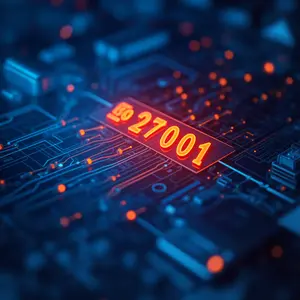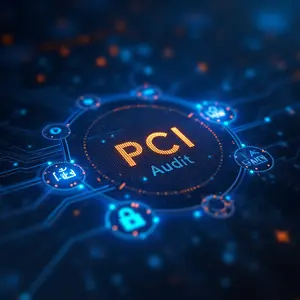Certifications and Compliance
Simplify IT compliance and achieve necessary certifications with our comprehensive services. Ensure security and meet regulatory obligations effectively.
What Are Cybersecurity Certifications and Why Do They Matter for Business Integrity?
Cybersecurity certifications validate an organization’s adherence to specific industry standards, demonstrating a commitment to risk management, data protection, and operational resilience. These frameworks function like architectural blueprints—ensuring that every structural element of security is precisely designed, documented, and upheld. Prominent certifications include ISO/IEC 27001 for information security management, SOC 2 for service organization controls, and PCI-DSS for safeguarding cardholder data. The core components of compliant infrastructures are SIEM platforms, encrypted communication protocols, and multifactor authentication systems. According to Cybersecurity Ventures, 60% of small businesses close within six months following a cyberattack, and 91% of executives report increased investments in compliance-related technologies. Consequently, certifications not only elevate organizational credibility but also provide a sense of security, fortifying defenses against escalating digital threats.

How Can ISO/IEC 27001 Certification Protect Sensitive Information?
ISO/IEC 27001 provides a comprehensive framework for managing information security risks through systematic controls, audits, and continual improvement. It prescribes implementing an Information Security Management System (ISMS), including documented procedures, risk assessments, and internal accountability mechanisms. This standard operates like a fortress blueprint—each wall, gate, and corridor meticulously defined to prevent breach or oversight. Core elements include access control via RBAC (Role-Based Access Control), logging mechanisms, and network segmentation. One organization attempted to enforce manual controls without a unified ISMS, resulting in inconsistent patch management and undetected privilege escalations. After integrating ISO 27001-aligned tools such as asset classification modules, policy automation, and encrypted audit trails, the enterprise stabilized its security posture and passed the certification audit. Notwithstanding early confusion, standardization brought consistency and compliance into alignment.
What Is SOC 2 Compliance and How Does It Support Client Trust?
SOC 2 compliance focuses on five trust service criteria: security, availability, processing integrity, confidentiality, and privacy. Reports are issued by independent auditors based on controls in place and their operational effectiveness over time. The framework resembles a public ledger of reliability, detailing exactly how systems are protected, monitored, and maintained. Technologies such as endpoint detection, disaster recovery configurations, and anomaly detection algorithms are core to achieving this benchmark. A SaaS provider, after struggling with fragmented logging and the absence of a consistent incident response workflow, managed to re-engineer the environment with centralized log aggregation, real-time alerting via SIEM, and documented incident handling procedures. This enabled the organization to meet audit requirements and secure key enterprise clients, bringing a sense of accomplishment and relief. Accordingly, SOC 2 elevates transparency and reinforces confidence in managed service offerings.
What Does PCI-DSS Require for Companies Handling Payment Information?
PCI-DSS (Payment Card Industry Data Security Standard) applies to entities that store, process, or transmit credit card data. It mandates encryption of cardholder data, restricted access, firewall segmentation, vulnerability scans, and secure software development practices. Compliance acts as a vault mechanism, containing, shielding, and constantly testing defenses around financial data. A retail chain suffered a data breach after failing to segment its payment environment, allowing malware to traverse unmonitored network paths. Reestablishing compliance involved deploying web application firewalls (WAF), encrypted point-to-point connections, and tokenization for card storage. System configuration logs and vulnerability scans were retained to meet PCI-DSS Requirement 10, ensuring traceability and forensics. Consequently, compliance requirements are not merely technical checkboxes but foundational safeguards against legal, financial, and reputational damage.
What Happens When Compliance Requirements Are Ignored or Incomplete?
Failure to address compliance obligations exposes enterprises to legal penalties, financial loss, and customer attrition. An e-commerce platform neglected GDPR, retaining customer profiles without explicit consent or erasure options. When a data subject filed a deletion request, the absence of policy enforcement and auditability led to a €180,000 fine and widespread negative press. The breach reflected a neglected dam—once fractured, the damage flooded downstream. Recovery required deploying data subject access request (DSAR) portals, pseudonymization protocols, and audit-ready consent logs. Alignment with GDPR Article 30 and ISO/IEC 27701 enabled the platform to regain public trust and regulatory favor. Accordingly, neglect carries a compound cost—rebuilding from reputational erosion is slower than designing defensively.

How Do Compliance Technologies Support Ongoing Regulatory Alignment?
Compliance technologies include automated risk assessments, configuration monitoring, and policy enforcement platforms. Tools like Qualys, Nessus, Vanta, and Drata enable continuous validation of system integrity, user access, and documentation workflows. These tools behave like an intelligent sentinel, constantly scanning, logging, and correcting in real time. One managed IT provider utilized static spreadsheets for access control reviews, resulting in delayed revocations and shadow accounts. Implementing an identity governance platform with automatic provisioning and real-time audits decreased control gaps by 82% and streamlined annual audit cycles. Audit trails were stored with timestamped integrity hashes, supporting NIST-compliant digital signatures. Accordingly, automation enhances visibility and scalability for teams managing multiple regulatory frameworks simultaneously.
What Role Does Employee Training Play in Maintaining Certification Status?
Human error remains the leading cause of security breaches, making ongoing employee awareness programs an indispensable compliance pillar. Training content should address phishing identification, secure authentication, data handling, and incident reporting. The knowledge infrastructure acts like immune conditioning, exposing the system to simulated threats to build real resilience. A healthcare IT provider passed technical audits but failed a surprise phishing simulation, revealing gaps in behavioral response. Corrective action included biweekly microlearning, gamified simulations, and compliance quizzes tracked via LMS dashboards. HIPAA-required privacy training was also expanded, with audit logs documenting participation for external review. This ongoing training not only sustains certifications but also makes the audience feel proactive and in control of their security measures.
How Should Organizations Prepare for Multi-Framework Compliance Audits?
Organizations operating across industries often face overlapping compliance frameworks. Alignment is achieved by mapping controls across standards and integrating common requirements such as access logging, encryption, and physical security. This approach functions like a master key—one control unlocking validation across multiple audit doors. A hybrid service provider underwent ISO 27001, SOC 2, and HIPAA assessments in a calendar year. Control matrices were mapped within GRC software platforms to streamline documentation, allowing each audit to extract tailored evidence without duplication. Encryption policies, vulnerability management, and incident response were cross-referenced and mapped directly to framework-specific clauses. Consequently, a unified compliance architecture reduces effort, increases clarity, and mitigates audit fatigue.
What Long-Term Benefits Are Gained from Achieving and Maintaining Certifications?
Certification instills repeatable discipline, measurable resilience, and reputational assurance. Long-term benefits include stronger vendor partnerships, faster sales cycles, better insurance terms, and fortified incident response. A cloud services firm that achieved ISO 27001 and SOC 2 Type II closed 29% more deals within six months, citing buyer confidence in security maturity. Insurance premiums dropped after underwriters reviewed and implemented controls and found full compliance with NIST and CIS benchmarks. Employee turnover in IT declined as engineers reported greater confidence in procedural stability. Accordingly, certifications are not vanity milestones—they are pragmatic investments that yield operational and reputational dividends.
Just Two of Our Awesome Client Reviews:
Frances Taylor:
⭐️⭐️⭐️⭐️⭐️
“Reno Cyber IT Solutions walked us through every step of the SOC 2 process with clarity and rigor. Their documentation templates, control mapping, and audit preparation were top-notch. What seemed overwhelming became achievable with their team guiding the way. We are grateful for such sharp, local expertise.”
Dylan Szewczak:
⭐️⭐️⭐️⭐️⭐️
“Our organization needed to comply with PCI-DSS and HIPAA simultaneously, and Reno Cyber IT Solutions helped build a cohesive compliance strategy. They didn’t just tell us what to do—they trained our staff and integrated the systems that made it sustainable. Their guidance was practical, professional, and truly local.”
Protect your organization and unlock new growth with Reno Cyber IT Solutions.
Our locally managed compliance services simplify certification while strengthening digital resilience. From PCI to ISO, we help you secure the future confidently and clearly.
👉 Contact us for a free consultation and learn how certification can become your most powerful business tool.
👉 Security starts with standards—master them locally.
Adhering to industry-specific certifications and compliance regulations is not merely a requirement but a fundamental aspect of maintaining trust, ensuring data security, and avoiding costly penalties. Expert IT services provide invaluable assistance in navigating the complex landscape of standards such as ISO 27001, HIPAA, PCI DSS, and GDPR. These services encompass comprehensive assessments of existing IT infrastructure, the development of compliant policies and procedures, and the implementation of necessary technical controls. By partnering with knowledgeable IT professionals, businesses can streamline the often-daunting process of achieving and maintaining compliance, demonstrating their commitment to security and regulatory obligations to both clients and stakeholders.
Furthermore, integrating robust cybersecurity practices is essential for meeting the stringent demands of certifications and compliance frameworks. IT services that specialize in security understand the intricate relationship between technical controls, administrative policies, and physical security measures required for compliance. They provide ongoing monitoring, regular audits, and proactive security updates to ensure that IT environments not only meet initial certification requirements but also maintain a strong security posture against evolving threats. By choosing an IT service provider with expertise in both certifications and cybersecurity, organizations can establish a resilient and compliant IT infrastructure, safeguarding sensitive data and fostering a culture of security and trust.
Ready to Secure and Support Your Business?
Your Reliable, Compliant, and Secure IT Partner:
Ready to Support and Secure Your Business Every Step of the Way.
